Xaudia now make P90 shaped hexaphonic guitar pickups!
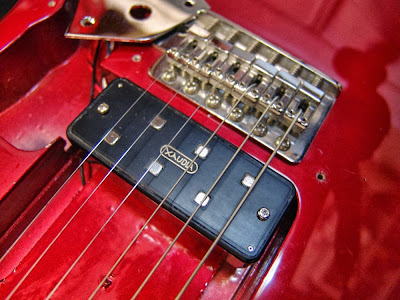 |
| P90 sized hexapup stereo pickup, installed in a Fender guitar. |
Xaudia now make P90 shaped hexaphonic guitar pickups!
 |
| P90 sized hexapup stereo pickup, installed in a Fender guitar. |
I recently installed one of our hexaphonic pickup systems into a a guitar for Matt Shaw, who is one half of Bobby and Jemima.
 |
| Bobby and Jemima… AKA Charlese and Matt (not sure who is who!) |
Matt provides a large chunk of the music for the act, playing guitar and drums – often at the same time – and he wanted to be able to send bass runs on the lower strings to a bass amp whilst simultaneously playing the melody and lead from the top strings out through a guitar amp. No problem at all!
I fitted a hexapup to the bridge position, wired out to a pair of output jacks, and an additional toggle switch gave the option of sending the G-string to either the bass or treble output. And we put one of our new P90 pickups in the neck position, with its own output for a third amplifier. Now Matt can make a lot of noise with one guitar!
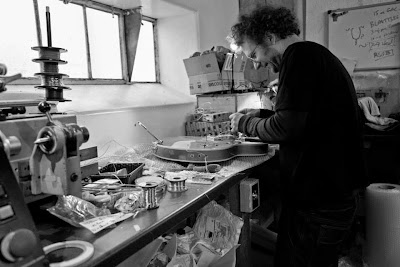 |
| Lots of mess during the pickup transplant. |
 |
| All stripped down and ready for the new pickups |
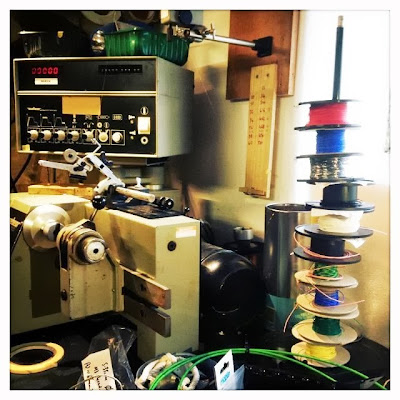 |
| Xaudia’s Meteor coil winder, and lots of wire! |
 |
| Some fine tuning of the setup |
 |
| All done! |
Installation – Mounting the pickup
The hexapup is a standard humbucker size and will fit into most humbucker routed guitars without modification. Please note that the hexapup gives best results in the bridge position, and because it uses strong magnets it not really suitable for use as a neck pickup.
1. Mono pickup
When wired as a conventional mono pickup, the hexapup has a bright single coil tone. The coil arrangement means that it has very good hum rejection (humbucking) properties.
2. Stereo guitar.
The simplest way to connect the hexapup for stereo use is to mount two jack sockets into the guitar, and wire one side of the pickup to each jack. The signal can then be run to two amps or DI boxes for gigging or recording. There are two obvious ways to divide the strings, the pickup can be supplied in either split or spread mode, with spread being the default.
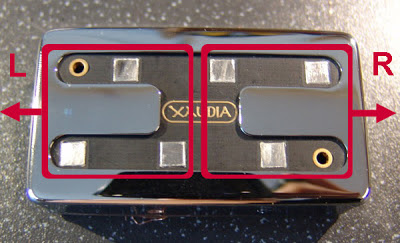 |
| Split mode – low strings are sent to one amp, high strings to the other |
Split mode sends the low strings E, A and D to one channel, and the high strings G, B & e to the other, like Neil Young’s stereo guitar. Spread sends alternating strings to each channel, that is E, D and B to one output, and A, G & high-E to the other, which gives a nice spread of frequencies across the stereo image.
Here are some sound samples of the pickup in split mode. As always the stereo image comes across better on headphones than laptop speakers!
 |
| Spread mode – alternating strings are routed to each channel |
Here is one of the riffs above in stereo ‘spread‘ mode.
In each case the playing is a single guitar, and the recording was made using the DI input of API A2D preamp into protools, processed using Amplitube amp modelling plug-in.
3. Mono / Stereo Jack
4. Stereo guitar with Split / Spread switch.
On request, the hexapup may be supplied pre-wired with a switch to choose either split or spread mode. Here is an easy way of switching between the modes.
 |
| Heavily modified Jagmaster with hexaphonic and stereo outputs. |
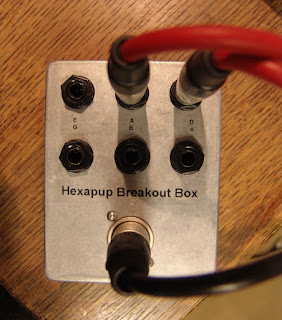 |
| Six channel breakout box for a hexaphonic guitar. |
Here is a sample recording made in hexaphonic mode, with the EA strings panned left, the top B and E to the right, and the D and G strings lower in level and somewhere in the middle. Different amp models (Amplitube) have been used for left and right.
There are some further sound samples of the hexapup in full hexaphonic mode here.
Xaudia Hexapup – Typical specifications
Dimensions
Fits in a standard humbucker route.
70 mm x 39 mm x 20.5 mm deep (25 mm including screw lugs)
Stereo model (3 coils in series)
DC resistance = 5.1 K ohms
Inductance @ 1kHz = 0.9 Henry
Wiring = Red & black, green & white.
Case ground = green/yellow
Red & green = positive, black & white = negative
Hexaphonic model (single coil)
DC resistance = 1.8 K ohms per coil
Inductance @ 1kHz = 0.31 Henry per coil
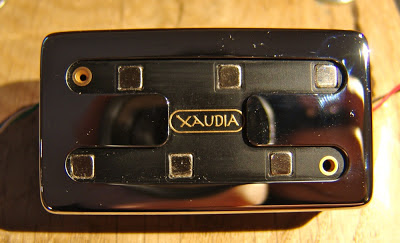 |
| Xaudia Hexapup |
A hexaphonic pickup lets you record you record the signals from each string separately, either through six amplifiers, or perhaps more sensibly by recording directly through instrument inputs or DI boxes. This gives a lot of creative possibilities.
For example, here’s a G major chord, played lazily from the low strings to the high. This was recorded directly into Protools, with the notes spread across the stereo width.
Adding an amp simulator gives it some body…
With a hexaphonic recording, it is simple to change the timing of individual strings. Imagine that we wanted the chord played tightly, rather than note by note. A quick edit and here it is…
Gmajor – all together
Or perhaps we would prefer to strum from the top to the bottom instead. No problem – we can just shift the notes slightly and we have it …
And by reversing the waveform of three strings and repeating the notes, we get this little ambient loop. A semi-reversed guitar
Now let’s get silly…
… we want to transpose part of a song, but the guitarist has gone to the bar. We can use Autotune on each track to pull each string up by two semitones to play an A major instead. Here’s how it looks on the screen…
And here’s how it sounds!
Auto-tuned Chord – Gmajor to A major
Of course we could have simply pitch shifted the whole chord up to achieve a similar effect – Autotune gives it an interesting glitchy slide texture as it chases the notes
By shifting the G-string up by one semitone rather that two, the chord becomes an A-minor. Now that’s something which can’t be done with simple pitch shifting!
Auto-tuned Chord – Gmajor to A minor!
The possibilities are endless!
One challenge when building prototype pickups is testing them quickly. It is easy enough to make the electrical measurements such as inductance, resistance and capacitance, but they don’t really tell you how the pickup is actually going to sound. Sooner or later they need to go into a guitar.
 |
| Squier by Fender Jagmaster ready for surgery |
This Squier Jagmaster guitar makes a suitable victim for surgery. It was fairly cheap, the neck is straight and plays well, and the strat-style trem cutout means that I don’t need to remove a huge amount of wood.
The first job it to strip the Jagmaster down, removing the strings, scratch plate and the existing hardware from the front of the guitar, and the tremolo system from the rear. Then off with the neck to keep it safely out of the way when the jigsaw comes to play.
Once everything is out then I measured up and cut two aluminium rails that will act as mounts for the new pickups. These were filed round at the ends to fit the existing routing, and drilled and tapped for mounting.
Then came the dirty work. With a jigsaw I cut through the body to make a humbucker-sized hole. You can see just how thin the wood is between the pickup and the tremolo routings – just a few millimetres.
One more job – the bridge no longer has springs to keep it under tension. A block of wood locks it in place instead. The guitar can now be put back together.
Now the pickup can be fitted from the rear with two screws attaching it to the aluminium rails. Screw terminals are also used to connect the wires to the output sockets for the ultimate quick change experience. A brass plate will cover the mess.
 |
| Rear of ‘quick change’ Jagmaster with locked tremolo and pickup mount |
Now it takes two minutes to swap a pickup! Time for some rapid prototyping. And here’s the front of the guitar with a hexapup fitted from the rear.
 |
| Jagmaster with Xaudia pickup fitted. |
One of the great things about being a micro-business is that you can act quickly! There is no management structure, no liaising with a marketing or accounts departments – we don’t have them! And best of all, no office politics! This means that if we have a good idea, or even a stupid one, we can do it straight away.
|
Hexapup in a Gretsch-style ‘toaster’ cover
|
Last month we made a stereo guitar pickup prototype, and it was fairly clear from our customers and comments on forums that a few people might want one. So now, six weeks later, we have a ‘production’ version in a humbucker sized* can – the Hexapup!
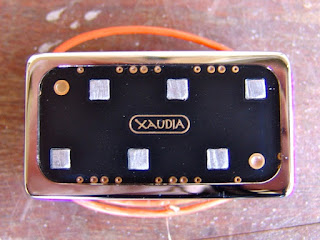 |
| Hexapup – hexaphonic guitar pickup |
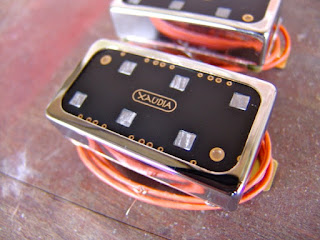 |
| Hexapup guitar pickup |
The hexapup is actually made of six small pickups, and can be wired for mono, stereo or hexaphonic output
Mono
When wired as a conventional mono pickup, the hexapup has a bright single coil tone. But it also has hum rejection (humbucking) properties because the coils on one side are reverse wound, with reverse magnet polarity.
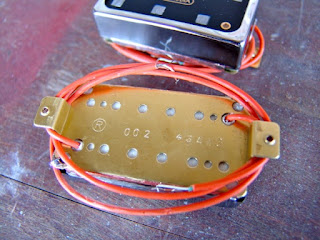 |
| Hexapup – serial number 002 with 43AWG wire |
Stereo
There are two obvious ways for stereo wiring. Either bottom-and-top, or alternating strings. Put another way, the lowest three strings can be sent to one output, and the highest to the other, so power chords could have one sound, and solos another. Or, the E, D and B strings sent to the left, and A, G & e to the right. This makes for nice stereo width, and is great for multi-tracking chords, and chorus type effects. I have my guitar wired this way!
 |
| Hexapup being mounted to a customer’s guitar |
Hexaphonic
Each coil can be given its own output, volume and tone control which, with series / parallel and phase options gives a staggering number of combinations. Each string can be sent to a different distortion or delay to get strange new sounds, and could even be auto-tuned or pitch shifted separately – that might be weird. With six outputs, imagination is the only limit!
I’ll be writing a bit more about the technical specs in a couple of days, so stay tuned.
* Actually a little deeper than a normal humbucker, but most guitars have plenty of space.